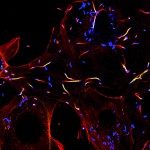Lien vers Pubmed [PMID] – 16406061
Immunol. Lett. 2006 Apr;104(1-2):156-65
Murine FcgammaRIIB were demonstrated to recruit SH2 domain-containing inositol 5-phosphatases (SHIP1/2), when their ITIM is tyrosyl-phosphorylated upon co-aggregation with BCR, and SHIP1 to account for FcgammaRIIB-dependent negative regulation of murine B cell activation. Although human FcgammaRIIB share the same ITIM as murine FcgammaRIIB and similarly inhibit human B cell activation, which among the four known SH2 domain-containing (tyrosine or inositol) phosphatases is/are recruited by human FcgammaRIIB is unclear. Our recent finding that, besides the ITIM, a second tyrosine-based motif is mandatory for murine FcgammaRIIB to recruit SHIP1 challenged the possibility that human FcgammaRIIB recruit this phosphatase. Human FcgammaRIIB indeed lack this motif. Using an experimental model which enabled us to compare human FcgammaRIIB and murine FcgammaRIIB under strictly controlled conditions, we show that SHIP1 is recruited to the intracytoplasmic domain of human FcgammaRIIB and inhibits the same biological responses and intracellular signals as when recruited by murine FcgammaRIIB. Identical results were observed in murine and in human B cells. We demonstrate that SHIP is necessary for human FcgammaRIIB to inhibit BCR signaling, and cannot be replaced by SHP-1 or SHP-2. Although it contains no tyrosine, the C-terminal segment of human FcgammaRIIB was as mandatory as the tyrosine-containing C-terminal segment of murine FcgammaRIIB for SHIP1 to be recruited to the ITIM. This segment, however, did not recruit the adapters Grb2/Grap which were demonstrated to stabilize the recruitment of SHIP1 to the ITIM in murine FcgammaRIIB.
